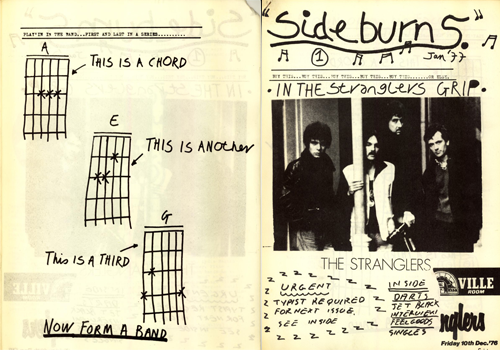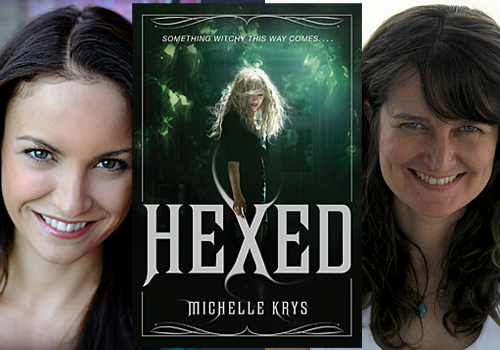Chris Baty's Blog, page 169
February 27, 2015
5 Tips for Launching Your Book (Cosplay May Be Involved)

The “Now What?” Months continue, and we’re shifting our focus to the wide world of publishing! Today, Lauren Harsma, former NaNoWriMo intern and current employee of Inkitt, an online writing community, shares five things to keep in mind as you start to send your book out into the world:
Finding an audience for your book is very similar to working at a startup. Your main feelings every day are uncertainty, exhilaration, and that damp, steaming sort of worry you get when you can’t remember if you locked your front door. You’re motivated largely by baby animal photos and desserts with chocolate filling. The light switch to your brain is gummed permanently to ON. You don’t sleep much.
Being in the thick of both sticky businesses hasn’t inoculated me against stress and weirdness, but it has given me insight beyond where to find good falafel just before midnight and the effect of coffee on a healthy bladder…
I’ve learned that no matter how many chapters you write or how many emails you send, you’re never truly finished with your work. Work like this is like shoveling the driveway while snow continues to fall an inch a minute. You’ll never catch up. The good news is you don’t want to.
Know your appeal before you publish.
This can be tough. How do you know if your story is honey or vinegar if the only people who’ve read it are your mom and your dog? Find readers who will give you honest feedback as your novel progresses so that you can course-correct before you’ve written and revised your entire book.
There’s always a drop-off with social media.
Be it running out of sources from which to mine readers, or driving those readers mad with constant self-promotion, there is always a time when advertising yourself on Facebook and Twitter stagnates. Never underestimate a little human interaction! Chat with people in cafés, at libraries, on the train. Go to writing and reading meet-ups to find people who love to read what you love to write, then sell them on it.
Be unique.
Use creative and interesting tactics that have never been tried before. Social media and flyers at bookstores are old hat—try getting crafty with promotional crochet, or walking around town dressed as your half-alien protagonist. Having lived in Berkeley and now in Berlin, I have it on good authority that crazy is catchy, and the inquisitive are bound to ask what’s up.
Team up!
It’s important to make connections in your realm, and not just the big ones: friends who have idea-babies the same size as yours are crucial. You can set up play dates and go through the painful teething process together, learn and grow and bat ideas around.
In writing, two (or five or twelve) heads are always better than one! Form a hydra of authors that together influence change and bring in an audience. See how close John Green and Maureen Johnson are? Look at all the street cred Whedon and Burton actors get from working with the same directors time and again! Plug each other, promote each other: you’re in this together!
Don’t let your fire burn out!
Invest in a fan for your coals: your tome-train has just left the station, and you’ve got to keep it chugging along down those tracks if you want your story to reach peak status.
Lauren Harsma is a dandelion seed. She aspires to adventure and artistry, and relocates according to whatever strange wind whisks her away. After three years in Berkeley, she now lives in Berlin, where she obsesses over delicious beer, dances on U-Bahn platforms, and runs communications and marketing at online story community Inkitt.
February 25, 2015
Submitting Your Manuscript: A To-Do List

The “Now What?” Months continue, and we’re shifting our focus to the wide world of publishing! Today, Samantha Streger, the director of publishing at Full Fathom Five Digital, an e-first publishing imprint, shares a to-do list for when you’re ready to start shopping your manuscript:
So you’ve finished your novel. It’s been edited, and revised, and you finally feel ready to start submitting your manuscript. Now what?
Figure out who will want to read it. Who is your audience: middle schoolers, Young Adults, adults who love YA, divorcées, thrill-seekers, dog-nappers? After you know who’s going to be interested in reading your book, you can easily find out what other types of books those readers like to buy, which have been the most successful, and who publishes those books. Look at a publisher’s and agent’s “About” page to see what types of works they’re interested in, but find out even more by looking at their online catalogs and bestsellers…
For example, digital publishers like Full Fathom Five Digital often go for commercially-oriented, genre-driven titles, while larger print publishers are looking for the highest concept and literary works. It seems obvious, but many writers don’t research the company they’re pitching. You may find that the most successful-looking titles in your genre are self-published. With that knowledge in hand, you can decide to follow the blogs of those authors, research publishing services, and self-publish your own work.
Go one step further with your research. No one loves to research (those who say they do are unicorns!) but a few days of collecting information can go a long way toward understanding where you should submit your manuscript, and why.
Subscribe to free publishing newsletters (like Shelf Awareness and Publisher’s Weekly) to learn more about the current news and bestsellers. Join LinkedIn and Facebook groups for writers, and look at the current topics. Follow publisher, editor, and author blogs, and see if there are new emerging trends.
For example: as of early 2015, science fiction is hot right now, but dystopian YA is on the way out. Does that mean you’re out of luck with your dystopian YA manuscript? Not at all. What it does mean is that you will have a knowledgeable pitch letter meant to convince an agent or publisher why looking at your dystopian YA is worth their time, despite the flagging trend.
Pitch & synopsize. Once you’ve done the research, and have found titles comparable to yours, you can pitch agents or publishers who deal with that type of work.
Unsure whether to try for an agent or go straight to a publisher? That is the perfect type of question for online author groups. Some publishers will not look at titles that are not submitted by agents, but many new innovative publishers (like FFF Digital) will.
When submitting a manuscript, include both a pitch and a synopsis. I’ve seen long synopses without a pitch, but the pitch is the necessary hook. Agents want to know how they’re going to sell your book to a publisher, and publishers want to know how they’re going to sell your book to readers. The pitch will tell them!
When writing the letter, think about how you would sell your book via Twitter—you only have 140 characters to tell it all. Then use this savvy sentence to hook an agent or editor. The rest of your (succinct!) pitch can include your knowledge of current trends and titles comparable to yours, making an argument for your work.
Don’t forget to sell yourself. It may seem counterintuitive to promote yourself as an author prior to actually having a book deal, but you’re doing the same thing an agent or publisher will be doing: trying to sell your work.
I love to see a pitch that includes an author’s own plans for marketing themselves. Not every author has an established web presence or marketing strategy, but even a website under construction and small social media following is appreciated more than a lack of information.
If you’re a member of an author’s organization, like Romance Writers of America, include this. If your NaNoWriMo manuscript has been read by over 100 people to great reviews and feedback, include this, and a blurb of the best review.
A well-written manuscript is only 1/4 of the publishing battle: authors always need exposure. Companies that will become your publishing partner particularly like to see that the partnership will be maintained when it comes to marketing and publicity. Your pitch letter is similar to a job application—make us want to work with you!
Be a minuscule bother, and then move on. Follow up if you haven’t heard from the places you’ve submitted your work in about three months time. When an author follows up with me, I’ll glance at where the manuscript is on my list, and potentially move it closer to the top. Just like with a new job prospect, it doesn’t hurt to show that you have continued interest in the company.
Remember that agents and editors will only acquire what we think we can sell, but we are not all-knowing. With each passing year, a rejection is less of a big deal: there are tons of options for authors publishing today, and too much information to keep track of. If you’re unsuccessful pitching the big five publishing houses, take a step back, and think about whether a new model could be right for you and your work.

Samantha Streger is the Director of Publishing at Full Fathom Five Digital, an e-first commercial publishing imprint that launched in October 2014. A veteran of the ebook business, Samantha was previously an editor at Open Road Integrated Media, where she built a children’s ebook list from picture books through YA novels. Prior to her position at Open Road, she worked as an Assistant Agent at the Wallace Literary Agency and Assistant Editor at Disney Publishing Worldwide. She received her graduate certificate in publishing from New York University in 2009. Curious about Full Fathom Five Digital? Find out more about us here. (But first do the dreaded research.)
February 23, 2015
7 Things Publishing Professionals Wish You Knew

The “Now What?” Months continue, and we’re shifting our focus to the wide world of publishing! Today, Holly West, an editor at Feiwel & Friends and the crowd-sourced YA Romance imprint Swoon Reads (a previous NaNoWriMo sponsor!), shares seven things writers should know about the publishing process:
So you finished your novel. Congratulations! That is a huge step, and one that takes no little amount of effort. But once you finish your novel, then comes the business of trying to get it published.
There are many ways you can do this (I work both on the traditional publisher side for Feiwel & Friends where I receive manuscripts through agents, and I receive young adult romance manuscripts through swoonreads.com, a crowd-sourced publishing imprint where writers submit their manuscripts directly). But no matter how you send in your manuscript, there are some things you should keep in mind that might make the publishing process seem a little less mysterious. I thought it might be helpful to share a short list of things that we as publishers wish authors understood:
We are real people. When people talk about publishing online, there’s a tendency to treat each publishing house like a faceless corporation. But really, each house has a lot of different imprints and each of those imprints are made up of a lot of different people—people who, for the most part, really love their jobs and genuinely love books..
We are only human. As much as we love books, and as much reading as we do—and we all do a lot of reading—there are only 24 hours in a day and we all need to eat and sleep and go to Taylor Swift concerts and watch movies and, you know, have a life outside of work. So while I’m genuinely excited at the thought of reading your book, remember that it might take me a little while to get to it, since there is only one of me and many hundreds of you, and I have to go to meetings and answer email, and write edit letters, etc.
And, speaking of edit letters, while I would really like to be able to give in-depth responses and advice to every author, I’ve sadly realized that its actually physically impossible without a Time Turner or a T.A.R.D.I.S. I’m really sorry!
Reading is a very subjective thing. Editors are readers, just like you, and each of us has our own individual reading tastes. So, you really should do some research before sending in your manuscript to an editor.
For example, I prefer commercial novels with a fast moving plot and characters I can fall in love with. I like fantasy and magic and books that make me laugh. Liz has been known to fall head over heels for books with beautiful language that make her cry, while Joy likes angst-y contemporary issue books. Take a look at other books that the imprint and editor has published before you submit and remember that not every book is going to click with every editor. You need to find the right fit.
There will be edits. I have never seen a book that didn’t go through at least one round of revisions, and many books will go through two, three or even four drafts before they get sent in to copyediting and then proofreading and more proofreading, etc.
Be prepared, and try not to panic when you get your edit letter. I know they can be intimidating (especially mine which tend to be many pages long with outlines because I’m wordy and a little OCD) but remember that we, as editors, would not have bought your book if we didn’t see something in it that we loved. We believe in you and your book, it’s just our job to help you make it the best book it can be. And again every editor has a different way of doing this.
Your submission still needs to be a good as you can make it. True, we don’t expect the manuscript to be perfect, but there are a lot of manuscripts out there, and yours needs to stand out from the crowd (most editors have lists and spreadsheets and complicated flagging systems in their email to keep track of the many, many submissions waiting for them).
So don’t send in your rough first draft. Take the time to revise on your own, and then run it past some beta readers before you send it to us. And make sure you spell check. I don’t care how deep and meaningful your story is, if you don’t care enough about your novel to read through it and fix basic typos and grammar mistakes and make sure that your main character’s name doesn’t change halfway through, why should I believe you will put in the time to do the necessary revisions?
Beginnings are important! I know that you’ve heard this before, but it bears repeating. I will give a manuscript three to five chapters (roughly 30-50 pages) and if you haven’t managed to hook me by that point, then I’m on to the next book in my overflowing to-read stack.
Don’t try to set up the whole world or tell me the characters entire backstory in the first few pages. Instead, get your main character on the page and give me a reason to care about what’s happening to them. Let them say something funny or snarky, do something heroic or stupid, or even be the lone voice of reason in a crazy situation beyond their control. Do something to grab my attention as soon as possible. You can show me the world and fill in backstory later, after I’m already invested in the character or story. I’ll actually have a reason to care about it then.
And remember, you have 30 pages to hook me, because I know that beginnings are hard. A reader in a bookstore will give you a page to hook them, if you are lucky. Sometimes you only get a paragraph.
We want you to succeed! I know that the publishing process is long and hard and that writing a novel is a huge commitment and that taking the time to edit and revise takes even longer. But don’t get discouraged. We are rooting for you. Even if I personally don’t click with your book, it might be perfect for another editor and I sincerely hope that you find them.
I have many authors that I love that aren’t published by my imprint or house and I’m really happy about that because it means that I have books I can read and fangirl over just for me. And while we might grumble a bit occasionally (Does John Green really need that many slots in the New York Times bestseller list? Really?), we love books, and every book and author that succeeds can be a win for books as a whole—after all, you are going to need something to read after you finish John Green’s entire backlist. ☺

Holly West is an Associate Editor at Feiwel and Friends where she works with authors like Emmy Laybourne, Josephine Angelini, Meg Cabot, and Mo O’Hara. She is also the editor for Macmillan’s crowd-sourced YA Romance imprint Swoon Reads, where she works with authors Sandy Hall, Jenny Elliott, Katie Van Ark, Temple West, Kim Karalius, and Karole Cozzo, among others.
February 20, 2015
Everything You Need to Publish a Novel

The “Now What?” Months continue, and we’re shifting our focus to the wide world of publishing! Today, Chris Angotti, NaNoWriMo’s chief operations officer, argues that you really only need three things to publish a novel:
In January of 1977, a British punk fanzine called Sideburns published one of the most influential infographics of all-time. It featured three crude guitar diagrams, along with this annotation:
This is a chord. This is another. This is a third. Now form a band.
The invitation was symbolic of the emerging DIY punk aesthetic: giving readers the tools to go from fans to creators. It was an acknowledgment of amateurism and imperfection, the idea that anyone could pick up a guitar and make noise. The resulting music might be good, terrible, or just okay (this category making up the majority of late-’70s UK punk), but the method to do it was accessible to everyone.
I think about that graphic a lot, and I’m proud that NaNoWriMo exists in the same tradition. We believe that anyone can write a book, and we try to provide the stuff to make it happen. (“This is the page. This is the deadline. This is your imagination. Now write a novel.”)
Unfortunately, publishing can often feel like a whole different story. There are so many gatekeepers to getting your work out there, so many boxes to tick to be an “expert” worthy of being widely read. These gatekeepers aren’t just external, either. They’re our inner editors, and our self-senses of talent, determination, and worth.
Today, I want to give you (or remind you of) some tools to help you move forward in the publishing process. Like those three chords in Sideburns, it’s the minimum of what you need—but sometimes that’s what’s most potent.
This is self-confidence.
You remember that you already wrote a whole novel, right? And chances are, you’ve got something there, even if it needs excavation. The hard part was sitting down and getting it out; editing, pitching, and publishing are all based on the work you’ve done already. You can do this, and your story deserves to be read.
This is acceptance of imperfection.
There’s a myth that your novel needs to be 100% perfect before you submit it anywhere. Sure, it should be very solid—as solid as you can make it. But agents and editors will help you make it better. Do all you can, but don’t let the effort keep you from ever putting it out there.
This is knowledge of the field.
Want to traditionally publish? There’s no shortage of information out there, including plenty on this very blog. Know how to write a query letter and make a list of the agents (and publishers if they accept direct submissions) active in your genre, and you’re off to a fine start.
If you want to self-publish, bootstrap some expertise on the best companies out there (we work with a few), plus the design and promotion skills you’ll need for later on.
Now publish a novel.
Pick up your manuscript and make noise.
— Chris Angotti
February 18, 2015
Tips from a Literary Agency: How to Query Better

The “Now What?” Months continue, and we’re shifting our focus to the wide world of publishing! Today, Danielle Barthel and Jaida Temperly of New Leaf Literary share their views from the inside on everything from deciding which project to start submitting to agents, to dealing with multiple-offer scenarios.
Also, join our tweet-chat with the agents of New Leaf Literary on Thursday, February 19 at 1 PM PST using the hashtag #NaNoNewLeaf!
Say you’ve finished your manuscript, your beta readers have read it and given you notes, and you’ve read and edited it yourself so many times that you could recite it in your sleep. You’re ready to start querying—but what are the dos? What are the don’ts? Here are a few thoughts to make your transition into the publishing industry a smooth one:
First, choose the perfect project to send out. It’s okay if you have more than one novel completed when you start querying—but focus on sending out one at a time, and choose your strongest for this purpose…
If you’re querying the first book in a series, say exactly that: “This is a standalone with series potential.” In the same way that you can’t guarantee who’ll love your project, you can’t guarantee that if you go on submission and get an offer that it will be for multiple books.
While we can only speak for New Leaf, every query we receive is read, and if we’re interested in the project you query, we’ll touch base and ask to set up a phone call. During that call, we’ll probably ask you about what else you’re working on—this is the perfect time to mention your other projects and ideas you have for future books.
Remember, it’s important to do your research. The benefits that will stem from this advice cannot be overstated. It will be one of the best tools in your query-belt.
To start, decide the genre and age group of your manuscript, and then query agents who actively represent your type of book. And query a set number of agents, too—choose a number you’re comfortable with and start with your ‘group A’. While we don’t wish this on writers, it’s a tough market and if none of your first round agents request your manuscript, you’ll want another round (at least) to send out to. Being prepared will make this a much easier step to take.
Before you continue querying, consider making some revisions if you’ve received feedback. It’s never a bad thing to jump back into your world to continue making it the best it can be.
If you’ve gotten far enough to have your manuscript requested, and you have a great conversation with an agent, you might get an offer of representation (yay!). Before committing to anyone, make sure to give other agents who might have your project a courtesy heads up. Give them time to get to your project if they haven’t yet (usually about two weeks is appropriate), because chances are good that it’s only because of time constraints that they haven’t read it before that point.
No matter who you end up going with in a multiple-offer scenario, agents will always appreciate being looped in, and this is a fact that will continue even after you’re agented. From there, it’s all you—make sure you feel comfortable and happy with the offering agent. It’s a close relationship, and you’ll want to know you’re in good hands.
Hopefully these ideas from industry insiders are helpful for your querying process. Best of luck!

Danielle Barthel began interning at Writers House following her completion of the Denver Publishing Institute. While there, she realized she wanted to put her English degree and love of the written word to work at a literary agency. She worked as a full-time assistant for three years, and continues to help keep the New Leaf offices running smoothly in her role of Coordinator of Team and Client Services.

Jaida Temperly moved from Wisconsin to NYC to intern at Writers House. Before that, she had a brief stint in medical school and milked cows on her family’s dairy farm. Jaida is currently an assistant to Joanna Volpe but in her down time, you can find her practicing yoga, downing coffee, or searching for the city’s secret bars and cemeteries.
Top photo by Flickr user -Snugg-
February 13, 2015
Tips from an Editor: Five Times to Say Yes

The “Now What?” Months continue, and we’re shifting our focus to the wide world of publishing! Today, Heather Lazare, editorial and publishing consultant, shares five “yes”es you have to check off your list, including “Yes, my novel is freaking awesome!”:
You did it! You wrote your book! NaNoWriMo inspired you to hunker down and get that first draft on paper. …And now for the heavy lifting of draft after draft. As a freelance editor, I like to encourage authors to get as much free help as possible before paying a professional. If you can reply yes to all of the below (be honest), then let’s talk.
You’re not the only person who has read your manuscript, right?
When you are so immersed in the process, it can be hard to see the forest for the trees (which, incidentally, is the title of a wonderful book on writing by literary agent and author Betsy Lerner). It’s essential to get feedback from others before approaching an editor. Read this great post for advice on how to find readers.
Did you take regular time away from your book?
It’s helpful to have a break, especially if all your free time since November has been spent editing, reading, and tweaking. Your brain has not had a chance to reset. Take at least a week away from your manuscript between each draft. You and your book will thank each other.
Are your first 20 pages freaking awesome?
Do not wait to tell us what your book is about. Do not spend the first fifty pages setting up what’s going to happen in the rest of the book. Get your plot going on page one and keep your reader turning the pages.
Freelance editors can book months in advance, so having those first pages as solid as possible will help score you a place in their queue. Then, while you’re waiting for your date to come up, you can continue the editing process on your own. An editor will certainly help make these pages even better, but remember that most editors aren’t going to read to page 150 to decide if they are interested in working with you.
Can you articulate what your book is about?
Don’t wait for someone else to tell you what you’ve written. Think deeply about your book and spend time figuring out your pitch. When an author is able to explain their book effectively in a sentence or two, I can tell they are focused and willing to put in the necessary work to make it even better.
Can you leave your ego behind?
You are about to pay someone to thoroughly read, critique, and edit your manuscript. This person is going to tell you that your book needs work. This can make you feel raw, annoyed, shocked, frustrated, and a slew of other emotions. Be prepared to listen and take in the comments and suggestions. An editor’s goal is to help their client create the best book possible, so always keep that in mind!
Happy writing and editing!

Heather Lazare is an independent Editorial and Publishing Consultant who has worked for Random House and Simon & Schuster. She lives in Pacific Grove, CA with her husband and toddler son.
Top photo by Flickr user @Doug88888.
February 11, 2015
Tips from an Agent: 5 Questions to Ask About Your Manuscript

The “Now What?” Months continue, and we’re shifting our focus to the wide world of publishing! Today, Lindsay Edgecombe, a literary agent at the Levine Greenberg Rostan Literary Agency, shares five questions to ask yourself about your manuscript before sending it out on submission:
I’m a big fan of NaNoWriMo and want to start by saying that if you are reading this with a draft of your novel complete, I am sending you my respect. That’s a huge accomplishment.
So you have the draft, you’ve let it rest, gone through some reads, and you have a hunch that somewhere in there, you have something pretty special. Something that could catch on. Something you want to publish. But how do you know when the novel itself is ready to go out into the world on submission?
As a book agent, I believe that one of the most useful skills you can learn about publishing is how to set the right intentions for yourself and your book. Writing a novel, you already know, is hard. Publishing can be hard, too. See this stage as an opportunity to learn and to develop resilience. There’s lots of advice out there about how to pursue agents and publishers (how to do your research, how to write a query, how to choose comparative titles—all important), and your job is to learn as much as you can, and then learn how to filter out the noise and do what’s right for your manuscript.
Here are some questions you might want to sit with as you work on your book and think about sending it out to agents or self-publishing:
Have you gotten outside reads? Have you gotten the right ones? Have you gotten enough of them?
You want to solicit feedback from readers whom you respect, then really sit with what comes back to you. Sit with the yucky, terrible feedback. Sit with the praise that makes you feel like you’re floating. Don’t touch the manuscript as you collect advice. Then make the decision about what’s right for your book.
Here’s the thing: publishing is wildly subjective, and the more you can learn how not to get blown off course, the better. This is a great way to learn to trust your own gut, because you’re probably going to get conflicting feedback. Let your early readers be your teachers.
Does your novel have a hook?
Is there an interesting premise that you can articulate? What called you to write it in the first place? What’s the kernel that feels important to you? Write this down and save it. Keep notes as answers come to you. These may well go into your pitch.
Is your novel a page-turner?
No matter what genre you’re working in, ask yourself: is your plot as tightly paced as it can be? This bullet isn’t easy, I know, but the pacing of your novel is incredibly important.
Learn how to construct plot. What do you think needs to happen next? When did you feel a little bored writing it? Ask your readers if they got bored and when. If you can push yourself on this skill, and master it in your book, it can make all the difference.
Is your title great?
Ideally, you want to have a title that you love as much as your novel. You want it to evoke sparkly things for the reader. You want it to be a little bit emotional, no matter what that emotion is. You want the reader to feel something, something related to your novel and what you have to say. So don’t settle. Maybe include an alternate title or two when you do submit. If you can get this right, it can really help.
Do you know how to approach an agent?
There are a number of useful resources online and in books about how to find an agent, and I don’t have room in this post to cover all of them. So here is a summary of the nuts and bolts of submitting to agents:
Do your research, and learn how to write a good query/pitch. Query multiple agents at once—enough that you’re giving yourself a good shot, but not so many that it feels sloppy. Personalize all queries. Have a good hook. Make yourself sound smart and human. List your chops. Don’t summarize plot. Workshop that query just like you did the manuscript, but know when to reject bad advice.Grappling with these hard questions now will make it easier for you later. Let your novel bake in its own time. As you are revising, you are strengthening this muscle of your own intuition about your work. Don’t be a perfectionist. Stay humble and hungry for the work itself.
Try to see approaching agents as a sort of a game. Rejection sucks for everyone. Only the good news matters. If I had a slogan above my desk, it would be that sentence.

Lindsay Edgecombe is an agent at the Levine Greenberg Rostan Literary Agency, where she has been for a happy ten years. She represents a wide variety of nonfiction and some literary and commercial fiction. You can read more about Levine Greenberg Rostan here and can find her at @LindsayEdgecom1.
Top photo by Flickr user Leo Reynolds.
February 10, 2015
The Fifth Annual NaNoWriMo Pitchapalooza!

A great pitch is one of the most powerful and underestimated tools you can have in your quest to be published successfully, whether you’re looking for an agent, self-publishing, or trying to get traction online. That’s why we’re hosting the renowned Book Doctors for their fifth annual NaNoWriMo Pitchapalooza.
And, to help you prep your pitch and get ready for all aspects of publishing your novel, join us for The Book Doctors’ How to Get Your NaNo-Novel Published Webinar , an interactive seminar that will break down the process of writing a query letter, finding an agent and/or publisher, and determining the right publishing strategy for you.
You wrote your 50,000 words (or got pretty close!). You’re a winner. You felt the high. Now what are you going to do with your precious manuscript? That’s where we, The Book Doctors, come in.
For those of you not familiar with Pitchapalooza, here’s the skinny: You get 250 words to pitch your book. Twenty-five pitches will be randomly selected from all submissions. We will then critique the pitches online so you get to see what makes a great pitch. We will then choose one winner from the group. The winner will receive an introduction to an agent or publisher appropriate for his/her manuscript. We will also crown a fan favorite who will receive a free one-hour consult with us (worth $250).
Beginning February 10, 2015, you can email your pitch to nanowrimo@thebookdoctors.com. Please do not attach your pitch, just embed it in the email. All pitches must be received by 11:59 PST on March 6, 2015. The 25 random pitches will be posted on March 15, 2015. Winners will be announced on March 31, 2015. Anyone can vote for a fan favorite, so get your social media engine running as soon as the pitches go up!
Like last year, we’re offering free 20-minute consultations (worth $100) to anyone who buys a copy of The Essential Guide To Getting Your Book Published. Just attach a copy of your sales receipt to your email and we’ll set up your consultation.
It’s been a great year for Pitchapalooza winners. Cathy Camper and Raul Gonzalez III were our Pitchapalooza winners from world-famous Powell’s bookstore in Portland, Oregon. Their middle grade graphic novel, Lowriders in Space, is the first in a two-book deal with Chronicle Books. CariNoga was the NaNoWriMo Pitchapalooza winner in 2011. Her novel, Sparrow Migrations, was a semifinalist in the 2011 Amazon Breakthrough Novel Award contest, the spring 2013 winner of the ForeWord Firsts contest sponsored by ForeWord Reviews, and was named a literary fiction category semi-finalist in the Kindle Book Review’s 2014 Kindle Book Awards. She recently received an offer from Lake Union Publishing, an imprint of Amazon Publishing.
Then there’s Pitchapalooza winner and NaNoWriMo veteran, Gennifer Albin. After she won Pitchapalooza, one of New York’s top agents sold her dystopian novel in a three-book, six-figure deal. Her third book, Unraveled, just came out this past fall. And these are just a very few of our many success stories!
Are you feeling a little unsure about exactly how to craft your pitch? We’ve got 10 Tips for Pitching:
A great pitch is like a poem. Every word counts.Make us fall in love with your hero. Whether you’re writing a novel or memoir, you have to make us root for your flawed but lovable hero.Make us hate your villain. Show us someone unique and dastardly whom we can’t wait to hiss at.Just because your kids love to hear your story at bedtime doesn’t mean you’re automatically qualified to get a publishing deal. So make sure not to include this information in your pitch.If you have any particular expertise that relates to your novel, tell us. Establishing your credentials will help us trust you.
Your pitch is your audition to show us what a brilliant writer you are, it has to be the very best of your writing.
Don’t make your pitch a book report. Make it sing and soar and amaze.
A pitch is like a movie trailer. You start with an incredibly exciting/funny/sexy/romantic/etc. close-up with intense specificity, then you pull back to show the big picture and tell us the themes and broad strokes that build to a climax.
Leave us with a cliffhanger. The ideal reaction to a pitch is, “Oh my God, what happens next?”
Show us what’s unique, exciting, valuable, awesome, unexpected, about your project, and why it’s comfortable, familiar and proven.
— The Book Doctors
February 9, 2015
Tips from an Editor: When to Trust Your Gut

The “Now What?” Months continue, and we’re shifting our focus to the wide world of publishing! Today, Laurie Weed, freelance writer and editor, shares her three best tips on preparing to work with an editor, including the best ways to disagree:
Writing is hard work—like mentally climbing Everest every day. When you complete a manuscript, you just want to lay down in the snow and sleep at Base Camp for about a month. Once you’ve done that, it’s time to get up. If publication is your ultimate goal, you’re going to need a Book Sherpa.
Like writers, editors come in different styles and it’s important to find a good match. That said, there are a few things all editors wish writers would do to prepare for the final summit—aside from running spell-check like it’s your job (because it is):
Read it aloud. Do this at least once, chapter by chapter, and once again straight through. You will be amazed at all the little things your ear will notice that your eyes did not. It’s also a great way to evaluate that mysterious thing called “flow.”
If possible, record yourself reading and then take notes while you listen to the recording. While you’re at it, try reading the whole thing in a different layout or font size—not for submission, just to trick your brain into thinking you’re reading something new. One writer I know likes to make her final revisions in a three-column layout and pretend she’s reading it in The New Yorker.
Don’t dread the red (pen). Editors adore their jobs. They love writing and writers, and the opportunity to bring out the best in both. But many writers flush with shame and experience grade-school flashbacks at the mere sight of red ink, no matter how helpful those red marks (or their word-processing equivalent) may be.
Personally, I find that bright green or a nice turquoise ink works just as well, and somehow softens the dread-red effect. However your editor marks up the manuscript, try not to overreact. Remember, red is the color of love.
Trust your gut. Yes, you should absolutely trust your editor (or find another one), and the process should involve more synergy than pain. Still, there will be revisions and, inevitably, some points on which editor and writer do not see eye-to-eye.
Before you dig your heels in for a serial-comma standoff, try to listen objectively to your editor’s reasoning. You chose this person, after all, to give your work the polish it needs. However, if a suggested change nags at you like an off-key note in an otherwise lovely composition, you should balk—politely.

Laurie Weed is a longtime freelance writer and editing Sherpani. She is also the co-founder and producer of Tales To Go, a monthly mobile subscription from Travelers’ Tales.
Top photo by Flickr user World T.E.A.M. Sports.
February 6, 2015
How the Relationship Between an Author and an Editor Is Different than You Might Think

The “Now What?” Months continue, and we’re dipping our toes into the wide world of publishing! Last year, we asked authors to interview their editors about the process of collaborating on a book. Michelle Krys, author of Hexed and its forthcoming sequel Charmed , spoke with her editor at Delacorte Press, Wendy Loggia about author naiveté and her approach to making suggested edits :
Hi! I’m Wendy Loggia and I’m an Executive Editor at Delacorte Press/Random House Children’s Books. Working with debut authors is something I love, especially when they write terrific novels. Michelle Krys’s Hexed, which was released June 10, 2014, was a project I knew I wanted from the moment I first read it. Although Michelle & I have emailed each other hundreds of times, there are still some things I’d like to know! So here goes:
What did it feel like when your manuscript was on submission to publishers? And then, when your wonderful agent, Adriann Ranta, told you there was interest?
I was very naïve when I went on submission to publishers. The full extent of my knowledge on the process had come from the rare interviews I was able to scrounge up on the Internet, which were all success stories. It had never really occurred to me that I could walk away from the experience without a book deal until my first rejection came in, which was followed by another, then another.
I became convinced that the book wasn’t going to sell. Imagine my surprise when I got an email from Adriann saying that she’d heard back from Wendy Loggia at Delacorte Press, and could I call her right away? That cliché about a person’s heart dropping into their stomach? I can confirm that’s a real thing.
What was your reaction to the first editorial letter for Hexed?
I was amazed that a stranger could completely understand my vision for the book—it was as if you were in my head! Your suggestions kept Hexed itself, while simultaneously improving it in ways that hadn’t occurred to me before but seemed obvious and natural once you’d suggested them. If I didn’t already know we were compatible from our initial communications, I knew the moment I got that letter. It was such a relief.
How did you approach edits?
My approach was to tackle the biggest and most time-consuming change first, taking care to thread it through the entire book, followed by the next most time-consuming change, and so on, until I was down to clarifying scenes and reworking sentences.
It’s a very satisfying approach. It’s like when you paint a room, and you reach the point where you’re just pulling off the tape and moving your furniture and art back into the room—the big job is done, and you’re beginning to see the new, prettier shape that all your hard work has resulted in.
What’s the biggest misconception out there about the author/editor relationship?
Definitely that the editor is “the boss”. Before my first editorial letter for Hexed arrived, I was prepared to make any change you asked for rather than risk rocking the boat. I was pleasantly surprised when the letter arrived and in it you’d stated that your comments were only suggestions, and that it was my story to tell, first and foremost. Working with you has very much been a partnership. I feel like my opinions are valued and sought out.
What’s the one question you wanted to ask me but thought better of?
I’m lucky in that I’ve always felt comfortable asking you anything that pops into my head, and if I’ve ever felt hesitant, I’ve asked Adriann, who has asked on my behalf. I can honestly say that the only questions I’ve thought better of are the ones that I know are unanswerable: how will Hexed do once it comes out, what are the chances it will be successful, etc. I think we can both agree I should keep those kinds of questions to myself!
Michelle Krys lives with her husband and son in Northwestern Ontario, Canada. She works part-time as a NICU nurse and spends her free time writing books for teens. Michelle is probably not a witch, though she did belong to a witchcraft club in the fifth grade and “levitated” people in her bedroom, so that may be up for debate. Hexed is her first novel. Follow @MichelleKrys on Twitter.
Wendy Loggia is Executive Editor at Delacorte Press, an imprint of Random House Children’s Books. Wendy has worked with some of the most talented authors writing today & edits middle grade and YA fiction. In addition to editing Michelle Krys, she is the editor of
Teardrop
by Lauren Kate;
Being Sloane Jacobs
by Lauren Morrill,
Don’t Even Think About It
by Sarah Mlynowski and the romantic thriller
The Here and Now
by Ann Brashares, to name a few.
Chris Baty's Blog
- Chris Baty's profile
- 63 followers



